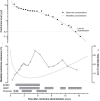Case Report: Colchicine Toxicokinetic Analysis in a Poisoned Child Requiring Extracorporeal Life Support
- PMID: 33898365
- PMCID: PMC8058177
- DOI: 10.3389/fped.2021.658347
Case Report: Colchicine Toxicokinetic Analysis in a Poisoned Child Requiring Extracorporeal Life Support
Abstract
Colchicine poisoning is associated with a poor prognosis, especially when leading to shock and multi-organ failure, and management is limited to supportive care, including multiple-dose activated charcoal. At therapeutic concentrations, colchicine elimination occurs mainly through hepatic metabolism and involves an enterohepatic circulation, with a small contribution of renal elimination (10-30%). Colchicine toxicokinetics is however rarely described, especially in children. We present the case of a 4-year-old patient who survived a severe iatrogenic colchicine intoxication with a dose of 0.5 mg/kg. She developed multi-organ failure and shock, but recovered after receiving aggressive resuscitation, including extracorporeal life support. Close monitoring of colchicine blood levels showed a plateau for 6 days, indicating impeded elimination resulting from liver failure. We observed no significant clearance from renal replacement therapy, nor activated charcoal, during this period. Extracorporeal life support may play a supportive role in the management of severe colchicine poisoning. However, extracorporeal techniques do not seem to improve colchicine elimination.
Keywords: ECMO; case report; colchicine poisoning; pediatric; toxicokinetics.
Copyright © 2021 Pérez Marín, Prod'hom, de Villiers, Ferry, Amiet, Natterer, Perez, Buclin, Chtioui and Longchamp.
Conflict of interest statement
The authors declare that the research was conducted in the absence of any commercial or financial relationships that could be construed as a potential conflict of interest.
Figures

References
-
- Thomas G, Girre C, Scherrmann JM, Francheteau P, Steimer JL. Zero-order absorption and linear disposition of oral colchicine in healthy volunteers. Eur J Clin Pharmacol. (1989) 37:79–84. - PubMed
-
- Bismuth C, Gaultier M, Conso F. Medullary aplasia after acute colchicine poisoning. 20 cases. La Nouvelle Presse Medicale. (1977) 6:1625–9. - PubMed
Publication types
LinkOut - more resources
Full Text Sources
Other Literature Sources

